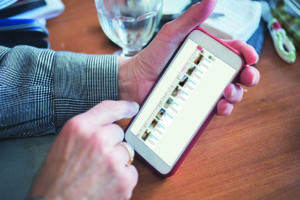 How to best combine optimal screening and diagnosis for atrial fibrillation (AF) has long been a challenge. At European Heart Rhythm Association Congress (EHRA; 18–20 March 2018, Barcelona, Spain) Jens Eckstein (University of Basel, Basel, Switzerland) presented the case for how modern technology can help to address this issue.
How to best combine optimal screening and diagnosis for atrial fibrillation (AF) has long been a challenge. At European Heart Rhythm Association Congress (EHRA; 18–20 March 2018, Barcelona, Spain) Jens Eckstein (University of Basel, Basel, Switzerland) presented the case for how modern technology can help to address this issue.
Atrial fibrillation (AF) is the most common cardiac arrhythmia and incidence increase with age. Those with atrial fibrillation have a three to five-fold increase in risk of stroke and are more likely to die or suffer disability if they do suffer a stroke. There were already different ways to diagnose AF—traditional resting electrocardiogram (ECG), 24-72h Holter ECG and implantable loop recorders—but there are now novel ways that make the most of modern technology.
Recently internet enabled mobile ECGs (iECG), an ECG band for Apple watch and smart detection of AF and cameras of mobile phones and smartwatches became available for AF screening too.
Two trials looked at these new technologies to see if they could accurately detect AF: the DETECT AF pro (Enhanced Diagnostics for Early Detection of Atrial Fibrillation–Prospective Validation) trial and the WATCH AF (SmartWATCHes for Detection of Atrial Fibrillation) trial.
The three methods tested in the WATCH-AF trial and DETECT AF Pro trial (smartwatch, smartphone and iECG) have varying availability and all three showed that long term screening is possible without inconvenient sticker electrodes that are needed for most traditional methods.
The intriguing aspect of a purely smartphone-based AF screening solution is the global availability, particularly as different models of phone can be used with the tested app. The disadvantage is that patients need to be active in assessing their heart rhythm.
This aspect could be solved by using a smartwatch which allows a similar degree of accuracy without active intervention on the part of the patient. With a suitable wrist worn device, and the tested algorithm, there is the potential for an almost ideal AF screening device.
Ecktein commented, “For all three technologies there is a huge potential for them to be used as efficient AF screening devices. Efforts have to be undertaken to achieve an optimal signal quality. We therefore fully support the already implemented signal quality check in the commercial version of the Heartbeats app. The next step will be a trial validating these technologies in a population based international trial to evaluate their beneficial use for our patients.”
The DETECT AF Pro trial
The trial was carried out at the University Hospital Basel and Greifswald (Basel and Greifswald, Germany) with 660 inpatients (330 with a history of AF and 330 matched controls). The inclusion criteria were patients of 18 years or older. Exclusion criteria included having a pacemaker.
Patients underwent a five-minute iECG with automated analysis and validation by a cardiologist, as well as a five minute photoplethysmographic (PPG) pulse wave recording with a smartphone camera (without information on signal quality or diagnosis). The data was analysed by the Preventicus Heartbeats algorithm in a blinded fashion.
A total of 672 subjects were assed for eligibility, of which 657 subjects were included and 594 underwent final analysis. There were 250 patients with AF and 344 patients with sinus rhythm.
The smartphone PPG readings were analysed with the Heartbeats algorithm for one, three and five minute files. Based on one-minute files, the analysis was 95.3% accurate, a three minute analysis was 95.7% accurate and a five minute analysis was 96.5% accurate.
The study investigators speculated that with a recording time of up to five minutes, compliance could be low, so they compared one minute analyses of the smartphone camera method/PPG using the Heartbeats algorithm for five minutes and one minute only in a predefined fashion.
The Kardia (AliveCor) algorithm (iECG) analysis took one minute and had an accuracy of 98.7%, but had a higher percentage of recordings without an automated diagnosis.
When both were compared with a one minute test PPG had a sensitivity of 90.0% (85.6–93.8) compared to 99.6% (97.9-100) for iECG. The specificity was 99.1% (97.5–99.8) for PPG and 97.8% (95.3–99.2) for iECG. The accuracy was 95.3% for PPG and 98.7% for iECG.
Taking into account the number of files not classified by the two technologies, the number of correctly classified cases was higher for the PPG technology (88.7% vs. 82.1%).
The WATCH AF trial
This trial was also carried out at the University Hospital Basel and Greifswald, with another 660 patients and the same inclusion and exclusion trial of the DETECT AF Pro trial.
The trial design was the same for DETECT AF PRO, using simultaneous five-minute recordings of a pulse wave with a smartwatch in one arm and an activity tracker with PPG sensor for pulse wave recording on the other arm and iECG to record an ECG from the fingertips. The PPG files were analysed by Preventicus in a blinded fashion. The automated iECG results were documented and the ECGs validated cardiologists.
There were 672 patients that were assessed for eligibility resulting in 508 subjects being available for analysis. This broke down into 239 subjects with AF and 269 subjects with sinus rhythm.
After a one minute test the smartphone had sensitivity of 90.0% (85.6-93.4) and accuracy of 95.3%. The iECG had a sensitivity of 99.6% (97.9-100) and n accuracy of 98.7% with a high number of ECGs without automated results.









